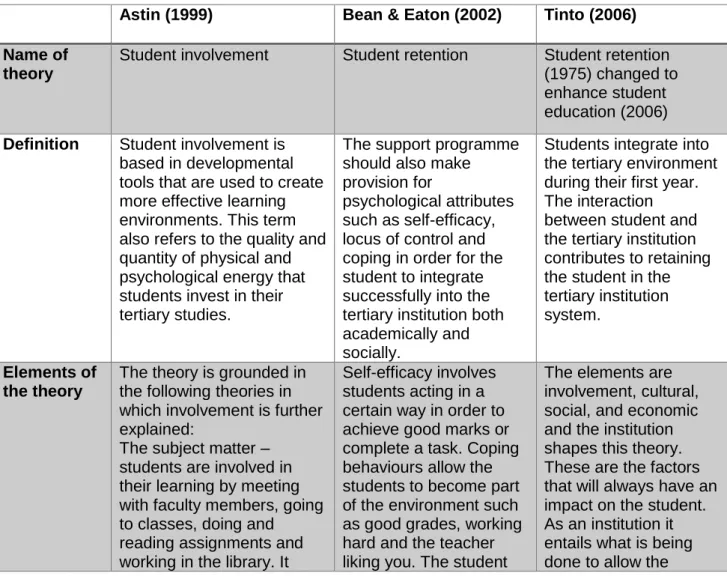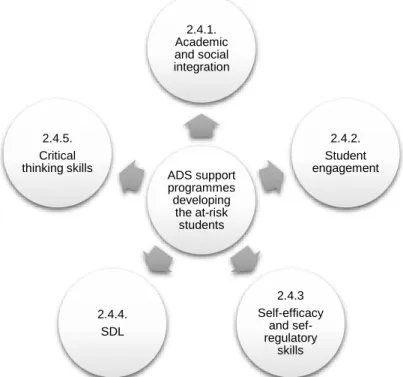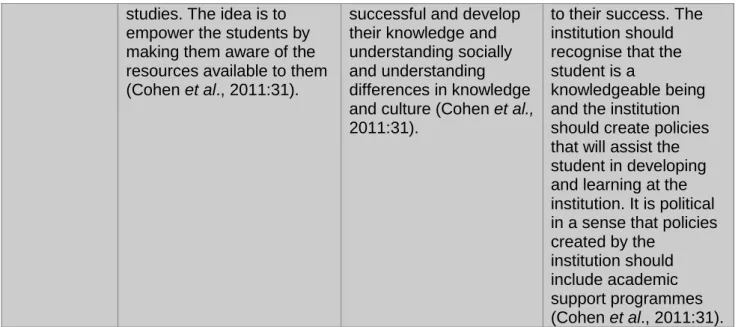The narratives gave the at-risk students a voice to help the Academic Development and Support Unit reconceptualize the factors that contribute to the profiles of at-risk students and improve its academic support programs. A scientific literature review was conducted to identify the factors that contribute to the profiles of students at risk.
- Introduction
- A historical overview of Academic Development and Support
- Background to problem statement and intellectual conundrum
- Research questions
- Primary research question
- Secondary research questions
- Purpose of the research
- Research design, methodology and processes
- Methodology: life design narrative
- Paradigm: critical theory
- Sample and research environment
- Method of data generation
- Method of data analysis
- Researcher’s role
- Validity and trustworthiness
- Ethical considerations
- Chapter outline in this research study
At-risk students are advised by the ADS counselors to use the available support programs (SI and Academic Peer Mentoring programs). 8 Secondary research Objective 2: To determine the nature of the support programs offered by the unit of academic development and support to develop at-risk students academically.
Introduction
- The academically prepared student
- Academic integration
- Ownership of learning
- Identifying learning strategies
- Goal setting
- Self-directed learning (SDL)
- The academically underprepared student
- Academic underpreparedness
- Cultural underpreparedness
- Emotional underpreparedness
- The academically at-risk student
- Limitation of critical thinking skills
- Limitation of self-directed learning
- The academic gap between secondary schools and tertiary institutions
- Ecological factors
- Difficulty integrating into a tertiary institution environment
Goal setting helps the student to focus on the reason why he is at a tertiary institution (Purnell et al., 2010:77). At-risk students in teaching environments may find it difficult to make the transition from school to tertiary institution because of the.
Academically underprepared vs. academically at-risk students
In the next paragraph, I discuss the similarities and differences between academically underprepared and at-risk students. The issue of critical thinking skills is identified as a risk factor because students.
The role of Academic Development and Support in supporting at-risk students
- The nature of academic support programmes offered at the ADS unit
- Theories that underpin Academic Development and Support programmes
- Peer-facilitated learning
- Cognitive development
- Vygotsky’s theory of socially mediated learning
- Social constructivism
- Self-efficacy theory
- The link between academic support programmes and retention theories
These academic support programs are offered to students to support and develop them academically to be successful in their academic career. Academic support programs have been developed to support students who usually do not perform well academically in their modules at the tertiary institution. Based on these theories, tertiary institutions have created academic support programs to help students have a better learning experience at the tertiary institution and to be academically successful (Demetriou & Schmitz-Scriborski, 2011:303).
Individualized theory - the curriculum must meet the needs of the student, not just the completion of the course. The following section discusses the academic support programs found in the ADS unit at Northwestern University, Vaal Triangle Campus.

Elements found in academic support programmes to develop at-risk students academically
- Academic and social integration
- Student engagement
- Self-efficacy and self-regulation skills
- Self-directed learning (SDL)
- Critical thinking skills
At-risk students are placed in academic support programs by a counselor to help them improve their academic performance. The key elements found in academic support programs to support at-risk students are discussed below. Students are encouraged to set clear goals and academic support programs assist students in achieving the set goals (Ning & Downing Schulze, 2010:92).
The ADS unit's academic support programs help at-risk students develop their critical thinking and strategy skills during support sessions. The five key elements are explained to at-risk students when they join academic support programs.

Academic Development and Support programmes in the digital age
The literature also shows that there has been a shift towards understanding the digital age and the implications for support programmes. Digital natives have an understanding of the digital language, while digital immigrants learn the language through trial and error. Students who are not exposed to technology can be disadvantaged in the digital world (Bennet & Maton, 2010:5).
When students have limited access to technology due to their background, they are called digital strangers and still need to learn the digital language (Bennet & Maton, 2010:7). In the context of South Africa, it has been found that due to the demographic differences of digital natives (also known as the internet generation), South African students may have a familiar digital background because they grow up with technology, or they may be digital aliens because they are not necessarily exposed to technology (Czerniewicz & Brown , 2010:859).
Conclusion
38 Exposure to technology can also mean that students have access to a large amount of information; they need to use the information gained to improve their skills and knowledge as it can enable the digital native/net generation to solve problems within the teaching and learning context (Bennet & Maton, 2010:7). When profiling students, it is therefore valuable to determine what level of technology the students have been or will be exposed to. The support programs offered at North-West University, Vaal Triangle Campus have not yet made provision to accommodate technology in an SI or peer mentoring session.
The academic support programs are not fully aware of the technological support students need in their learning for academic purposes. Based on the literature mentioned above, it is becoming increasingly important for ADS programs to take technology into account in this digital age.
- Introduction
- Methodology: life design narrative
- Phase 1: Orientation
- Phase 2: Re-authoring narratives (Transformation)
- Phase 3: Action plan
- Paradigm: critical theory
- Sample and research environment
- Method of data generation
- Data collection – Phase 1
- Data collection – Phase 2
- Data collection – Phase 3
- Method of data analysis
- Validity and trustworthiness
- Ethical considerations
- Conclusion
The life design narrative methodology guided the student participants to write their narrative according to their experiences within the tertiary institution. The student participants in this research study were given the opportunity to re-author their narratives to choose their own successful path at the tertiary institution. A narrative prompt (Appendix B) was given to the student participants so that they could write their narratives again.
Microstories helped the students to use their knowledge and make sense of their experiences at the tertiary institution. The meaning of the stories was conveyed by the students participating in the different phases of the narrative methodology for life design (Savickas, 2012:15).
Introduction
Profile of the student participants
Biographical data collected from participants provided information about the profile of student participants that may not necessarily appear in a written narrative. The student participants profiled were from a diverse group of students and all studied different programmes. It is interesting to note that it took Mlilo an hour to travel to the campus; this took up a lot of her time and she stated that she could not join any social activities on campus because she had to travel home.
Shinji lived in the residence, but he said that he is "not a social person", so it is possible that he was isolated from the other students in the residence. It is very important for a student to be able to finance his/her studies.
Narratives of the student participants
- Blake’s narrative
- Shinji’s narrative
- Mlilo’s narrative
- Pepe’s narrative
I can get my own place because it would help me put more hours and effort into my studies. I've started spending more time in the library after classes because I know I won't be able to do much schoolwork when I get home. I would like to get a place closer to school so I could attend all my classes and extra classes (SI).
Financially it was difficult to cope with my mother with her studies and she is paying from her own pocket. The goal I achieve is to have more peers with whom I can be able to discuss the content of the work.
Narrative verbatim quotes and coding per phase of the data collection
Sacrificing and providing for myself was not difficult, but rather something that I constantly failed to do. I find it difficult when the lecturer just shows slides and doesn't give students time to ask questions or check if they actually get the work they are supposed to do." SI helps me to do summaries so that we can meet again I can have notes that we can discuss.”.
In addition, this process helped me to make sense of the responses within the data collection phases. The codes indicated that the learners were able to identify their own learning gaps.
Discussion of emerging themes
- Financing studies
- Institutional support
- Academic Development and Support programmes
- Time management
- Academic and social integration within the tertiary institution
- Collaboration (learning from peers)
- Career path planning
- Developing academic goals
Perhaps she did not realize that the tertiary institution was actually trying to provide her with academic support for her studies. Mlilo has to travel an hour to the tertiary institution and back home every day. It was clear from all the student participants' experiences that they were unaware of the workload at the tertiary institution (2.1.2.1).
Instead, he was advised by the tertiary institution to study a Bachelor of Arts in Public Management and Governance. By the time Mlilo got to the tertiary institution, she had already decided to study towards a degree in education.
Conclusion
She set the academic goal of becoming more engaged in and taking more responsibility for her academic career by striving to successfully complete her academic work. As a result of this insight, he has decided to take responsibility by spending more time on his studies and less time on the social aspects of his life. Within the students' narratives, it becomes clear that despite failing their modules, they take responsibility for becoming academically successful.
Common among all student participants is the goal of focusing more on their studies and setting goals to help them become academically successful. When all student participants set goals for themselves (2.1.1.4), this is a factor of academic readiness.
Introduction
Overview of research study
In the discussion aspects such as the tertiary environment as well as the two academic support programs in place at the ADS unit of the North-West University, Vaal Triangle Campus for vulnerable students were explained (SI and an Academic Peer mentoring) program). The students are identified as at-risk students and they are notified by the tertiary institution to seek academic support from the ADS unit. This helped me find factors for underprepared students and eventually find factors for at-risk students.
Once risk factors were identified, attention was paid to appropriate academic support programs. In my discussion of the elements of the ADS unit in the academic support programs of Northwestern University, Vaal Triangle Campus, I indicated that I had discovered that these elements can support the at-risk student in academic development.
Significant findings
- Contributing factors to at-risk students’ profile
- The nature of the Academic Development and Support unit to support at-risk
- The voice of the second year at-risk student
The analysis revealed that the students struggled within the tertiary institution as well as in their local communities. The analysis showed that the students were not aware of or sufficiently prepared for the workload at the higher education institution. Further examination of the literature revealed that the academic support programs can increase retention - the higher institution's ability to retain its students (2.3.3).
The stories of the participating students showed that they only came into contact with the ADS unit after receiving a warning letter from the tertiary institution (1.3; 2.4). When the students entered the tertiary institution, they did not understand that the ADS unit is an academic support structure.
Suggestions based on the main research findings
- First year students’ exposure to the ADS unit
- Warning letters and early detection
- Lecturer involvement
- Digital age
- Academic support programmes for online or distance students
The ADS unit must assist students more effectively and efficiently by understanding the experiences of at-risk students currently involved in the academic support program. Their voice was used to understand their experiences in their academic career in the tertiary institution and in the academic support programme. Academic support programs may include training SI leaders or peer mentors to use technology learning aids in their SI or academic peer mentor sessions.
Currently, to my knowledge, there is no appropriate academic support program to support distance or online students. SI leaders and peer mentors can be trained to become part of the online classroom to provide academic support to online or distance students in a digital environment.
Limitations of the research study
- Student participants
- One tertiary institution
- Oral narratives vs. written narratives
The academic support programs offered by the ADS unit do not use technology to support the digital age; therefore, the ADS unit must reconceptualize their programs to cater for the digital age.
Recommendations for further research
- At-risk students’ experiences across all campuses and other tertiary institutions 87
- The supplemental instruction co-ordinators’ perceptions of the SI programme
Conclusion
The study also revealed that at-risk students need an academic support program that will help them understand the structure of the tertiary institution's environment. Academic development for improved efficiency in the higher education and training system in South Africa. A learning facilitation framework to promote academic skill development among underprepared learners in South African higher education.
OBE and EVL and good adult education: good bedfellows in higher education in South Africa. Study title: Academic Development and Support at a tertiary institution: narratives of second-year at-risk students.
